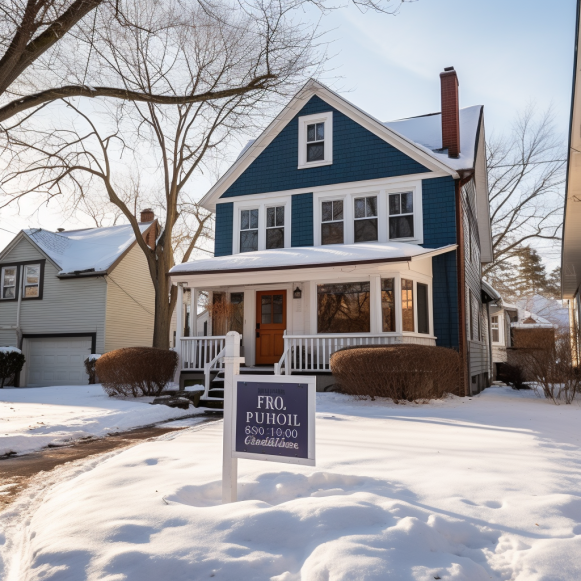1 in 8 home sellers in this part of the Bay Area is taking a loss

Most in-the-red sellers in any major region in the country
It may be difficult to believe in this real estate market, but one out of every eight home sellers in San Francisco and the Peninsula is now losing money.
How is that possible?
Mortgage rates are to blame. Rising interest rates have caused home prices to fall from historic highs reached during the pandemic homebuying boom. And some sellers who purchased at the peak of the market in 2021 and 2022 are being forced to accept less than what they paid.
According to the most recent data from the real estate brokerage firm Redfin, more than 13% of those who sold homes in San Francisco and San Mateo counties between August and October lost money — a figure that is nearly four times the national average and the highest share of any major region in the country. The average loss in the area is $122,500.
According to Sheharyar Bokhari, a senior economist with Redfin, those selling at a loss usually do so out of necessity. They may be going through a job loss, divorce, or other life event that makes it impossible for them to wait for things to improve.
“They’re moving because they have to,” explained Bokhari.
Julia Roberts, the actress, is one recent profiteer.She reportedly sold her six-bedroom San Francisco Victorian in October for a cool $11.25 million after purchasing it for $8.3 million in January 2020, just before prices began to rise.
“The vast majority of people who are selling, they’re making good gains,” Bokhari said, referring to Roberts.
Only 3% of sellers in the South Bay took a loss, which was typically around $100,000. In the East Bay, nearly 4% accepted less money than they had originally paid, with a median loss of $50,000.
Bokhari attributed the higher proportion of losing sellers in San Francisco and the Peninsula to the fact that prices for many of the area’s more expensive properties peaked during the boom before plummeting when interest rate hikes squeezed buyers and chilled the market.
According to the California Association of Realtors, the median single-family home price in San Mateo County in October was $2.1 million. This represents a roughly 13% decrease from the peak of the local market in April 2022, when the median price topped $2.4 million.
San Francisco saw an even bigger drop, with prices falling 20% to $1.65 million. The median price in the Bay Area fell 15% from its peak, reaching $1.27 million in October.
Despite the downturn, Peninsula real estate agent Jeff LaMont said he’s seeing up to 15 offers on some properties, with many exceeding the asking price.
“I would still classify it as a seller’s market, just not a seller’s market on steroids,” said LaMont.
Many would-be sellers, however, are still on the fence, unwilling to give up the lower interest rates they secured prior to the recent spike. The constant barrage of news about sky-high interest rates, which can increase monthly payments for new mortgages by thousands of dollars, is only adding to sellers’ trepidation, according to Silicon Valley agent Mary Pope-Handy.
As a result, the market inventory of available homes remains limited.
“It’s like the toilet paper shortage,” she told me. “People say there’s a scarcity, and then there is.” Except this one is genuine.”
However, there may be signs of relief. On Thursday, Freddie Mac reported the fifth consecutive week of mortgage rate declines, with the average rate for a typical home loan falling to 7.22% from 8% in late October.
Some economists predict that rates will continue to fall well into next year as inflation cools, but few expect a return to the all-time lows that fueled the market during the pandemic. Rates will fall to 2.67% in December 2020.
“The current trajectory of rates is an encouraging development for potential homebuyers,” Freddie Mac’s chief economist Sam Khater said in a statement.
Sellers who hold out for a better deal may also be eligible for a reduction in the agent fees they must pay when a sale is completed.
Sellers typically pay a commission split between their agent and the buyer’s agent, totaling 5% to 6% of the sale price. A federal court, however, ruled in November that major brokerages, including the National Association of Realtors, had conspired to keep fees high. The decision may force the industry to restructure and lower such fees in the future.
“This matter is far from settled,” association president Tracy Kasper said in a statement. “We will appeal the liability finding because we stand by the fact that NAR rules serve the best interests of consumers, support market-driven pricing and advance business competition.”
What is LaMont’s advice to anyone who is hesitant to enter the market in the midst of all the uncertainty? Consider a new home as a long-term investment, and you can expect prices to continue rising.
“As long as you can hold on for five years, you’re never going to be hurt by the ebbs and flows of the marketplace,” he added.
Following San Francisco and the Peninsula, Detroit and Chicago had the highest percentage of sellers losing money, at around 7%, followed by Cleveland and New York at around 6%.





